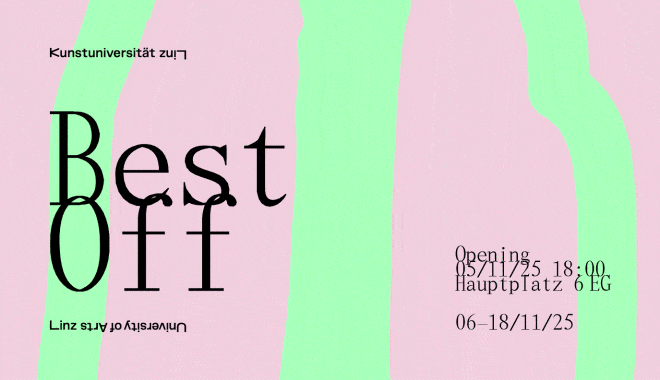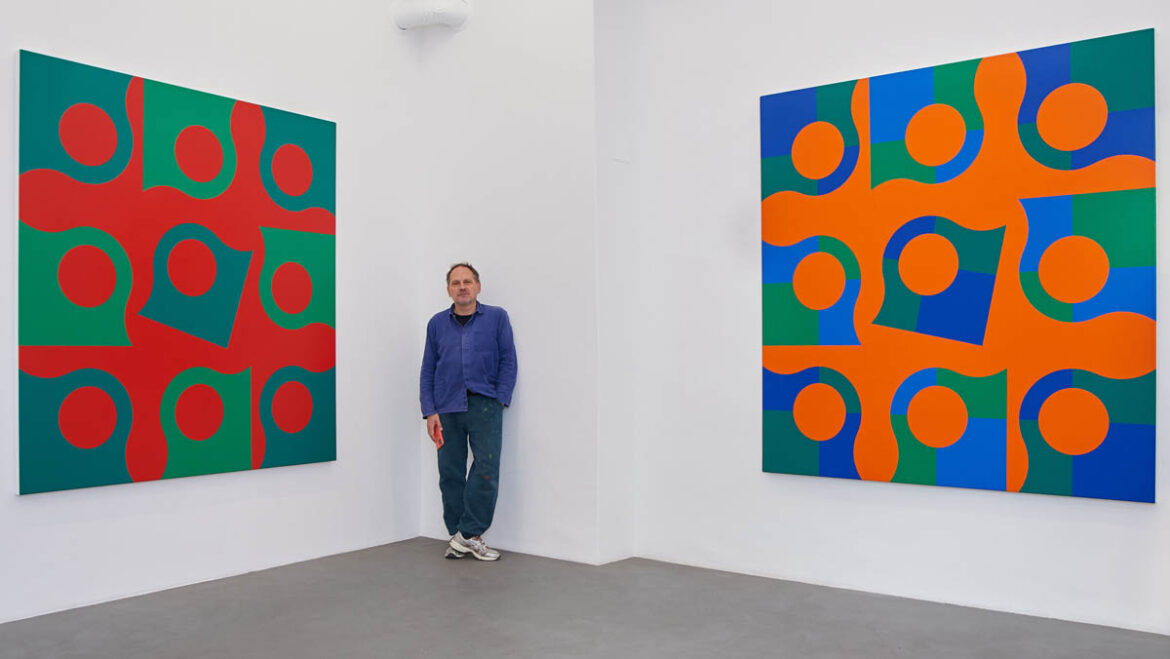
Christian, when did you start collaborating with Gallery Gezwanzig, and how did that come?
The journey began in the middle of the previous year, 2023. Our mutual friend introduced us and brought them to visit my studio. And since then we have communicated and started to work together.
Your work often includes geometric shapes and structured forms. What draws you to these forms, and how do they interact with themes in your work?
Basis of all of my works: painting and collages are drawings that are coming from the observation of everyday life; it is more complex than just drawing a shape; all is coming from my point of perception of city life that leads to these geometrical forms in the end via different processes of reduction and so on. I am not working in fragments but on the opposite. There is evolution behind this idea of the organic spine that holds the works together. The organic idea evolves and transforms through different forms, subjects, and color schemes. There is also this aspect of the body and scale of the forms I paint that is often connected to the body; for example, in the paintings I did it a few years ago; when you stand in front of them, it’s like mirroring the body, having the same size and shape as them.

How does it feel when you are walking on the streets and working on a new piece? What are you finding interesting?
Signs on the streets, traffic signs, shop signs, specific signals on the street—of course, this is not the only thing, but in this case for this exhibition, this was one of the things that inspired me.
How would you explain your process of making?
On one hand, it’s about establishing a sense of order; my paintings often appear strict and hermetic. Yet, organic elements then “disrupt” this rigid structure. On the other hand, these elements also create “creatures” that engage in various forms of interaction. It’s ultimately much more about communication than one might initially think.

How hard is it for you to make works like this with such attention to detail and very well executed with a strong focus? How do you start to work on the piece?
This painting requires a lot of time and concentration, and with large paintings, there is also a physical aspect that can be tiring. I always start first with the background and the forms I draw with pencil and cut in cardboard so in a very analog way. I use a lot of masking tape. The symmetry in shapes is very hard to execute in the way I am working, so there are always differences in them. This process of just positioning takes for sure a few days. And I work for sure on paintings for a month; sometimes it can be even more.
How do you collect your ideas? Do you have a sketchbook? Are you just drawing or also writing?
I have a lot of A4 papers, so single sheets, and it is always a mix of memories and ideas in different forms. Sometimes I write names, and sometimes funny stuff… I am thinking sometimes of showing them because they are otherwise lying in boxes in my studio.

How do you come up with amazing color schemes for your work? How have the colors in general evolved in your work over time?
For many years, I worked with a very pastel color palette, influenced by the themes of my paintings. Pieces from twenty or twenty-five years ago are very pale, in soft pinks, beiges, and various browns. The shapes in these works, each with an artificial gravity, are positioned or ‚resting‘ passively within the composition. I felt that these soft colors suited the subject matter well, and one reason I used them initially was that they matched my early experiences with painting at university.
Over time, this palette started to feel limiting, so I began using colors straight from the bottle, which sparked ideas for new themes. I wouldn’t have painted these new shapes without the color shift. I wanted to push this even further in the exhibition Signal, experimenting with these vibrant colors on a large scale. It was an exciting experience to work with these colors on large canvases.
An interesting fact about the exhibition „Signal“ is that I was again using gray in combination with other colors, so it seems as though the gray floor of the space influenced the color in the painting.
How are you feeling now after the exhibition is open? And give us a little introduction about the previous exhibition „Signal“ and now „Signal 2“.
I’m still amazed at how well the space, with its lighting and architecture, complements the works. It’s essential for the space to harmonize with the exhibition.


What is your “favorite” work in this exhibition?
It is very hard to say; I would not point out any for a favorite, but I like these small, specific works I produced here. I have a special connection to them because they have a limited time of existence, which is only while the exhibition is running.
Signal I was in a very huge space in Elektrohalle Rhomberg in Salzburg where I show paintings all the same size and one large wall painting in the middle of the space, and here I have two large paintings and four small paintings and two editions produced for the occasion of the exhibition, alongside small site-specific works.
It is interesting how sometimes your work has this moving illusion in its mix of geometry and color.
Yes, for this to work, it was important to find the right tones and shapes.

Your paintings are also interpreting personal relationships. What do friendship and family mean to you?
It means a lot to me. Sometimes, I see the interaction between shapes as dynamics between family members or different characters, in a way.
What role are digital tools playing in your work?
Technology in that sense and digital tools are not playing any role in my work or my process. A lot of people think that I am trying around the composition or the colors first in the programs, but this is not the case.

Are you working seven days a week?
One part of my apartment is my studio, so I live almost in it. I am in the studio every day, but I don’t work intensively seven days a week, some days more, some days less.
What do you think are the limitations of the two-dimensional space of the painting, and what are the unlimited possibilities in the painting?
Forms inside the painting interact with each other in a way we interact with the painting. When I am making new works, I always have space in mind and its characteristics, so the space where the paintings will be seen and how their size and format are with that space.

Florian, what makes your gallery unique as a new space in the contemporary art scene in Vienna, and what is your way of working with the artists you represent, including Christian Hutzinger?
We just started last year, so we are still a young and new gallery. The most exciting is the work together with artists and the direct communication we build from day one. The structure and support we provide are strongly complemented by their powerful work and inner structures. I think this balance is in between the full discipline and structure and the freedom of, so to speak, chaos. The idea was long there; I grew up surrounded by art, and my grandfather was an art and antique trader. Ten years ago I realized I wanted to start a gallery for contemporary art; searching for the right space and location was a quiet process, so like everything in life, it needs time, so here we are today. We are really happy with how everything looks and works now.
CURRENTLY ON VIEW:
Exhibition: Christian Hutzinger – Signal 2
Exhibition duration: 11. September – 22. November 2024
More information about the exhibition can be found here.
Address and contact:
Gallery Gezwanzig
Gumpendorfer Str. 20, 1060 Vienna
www.gezwanzig.com
www.instagram.com/gezwanzig/
Christian Hutzinger – www.christianhutzinger.com, www.instagram.com/christianhutzinger
Christian Hutzinger (*1966), born in Vienna (AT), lives and works in Vienna, Austria. 1991—Studies at the University of Applied Arts, Vienna. 2000—State Scholarship for Fine Arts.
Even if the pictorial works are to be read formally as layers, they can be conceived and understood as a dissolution of boundaries towards space since the clearly enclosed forms are always in constructive tension with the pictorial surface of the canvas. In some paintings, individual elements free and detach themselves from a structure like components, loosening from symmetry and seeming to want to detach themselves from the painting surface as bodies within it. (Text by: Niklas Koschel)




